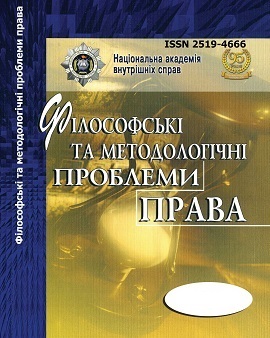Semiotic Methodology in Philosophical-Legal Discourse: the History of Formation and the Topical Problems of Development
Abstract
The article investigates the actual state of semiotic researches of legal reality and outlines semiotic-legal discourse perspectives. The author notes that the roots of all the diversity of semiotic and legal ideas, which are considered to be the original achievements of thinkers of later eras (in relation to the nature and essence of the sign, the presence of clear parallels between the universal symbolic organization of human existence and the symbolic reality of political and legal phenomena, etc.) are in the ancient and medieval philosophical heritage. In the Middle Ages the essential foundations of the Christian political and legal doctrine were outlined (they were set forth in the biblical texts and works of the church fathers about the relation between spiritual and secular authority, medieval doctrines of law). This doctrine has been reflected in all subsequent searches for a fair social and legal order.
At the same time the concepts of the sign in the interpretations that were proposed by Augustine, Boethius, St. Thomas Aquinas, R. Bacon, William of Ockham and other scientists were revised and supplemented. It is thanks to the creativity of the medieval and post-medieval scholastics the understanding of the sign has finally expanded – the repertoire of the signs was added, spiritual essences were included in the number of signs (whereas in previous studies signs are sensually perceived).
Semiotics existed as part of logic in the Middle Ages, the Renaissance, and at the beginning of the New Age. Humanists of the Renaissance (M. Ficino, L. Walla, J. P. della Mirandola and others) developed the political and legal ideas of Plato and medieval thinkers, they interpreted the main problems of the philosophy of law anthropocentrically and drew attention to the appointment of human existence as spiritual beings. Thinkers of the New Age (first of all, F. Bacon, J. Locke, T. Hobbes) presented integral philosophical and legal theories, they parallel developed the original doctrine of signs, which led to J. G. Lambert substantially expanded the boundaries of philosophical semiotics later on.
Thus, in the twentieth century, semiotics creates its own academic tradition and is divided into three main branches: syntax, semantics and pragmatics. Syntax examines the relationship between signs and their components. Semantics examines the relationship between the signs and the signified ones. Pragmatics examines the relationship between a sign and its users. Interdisciplinary studies of law from the standpoint of semiotics competes with many other approaches, they also contribute to solving important problems of philosophical and legal science, bringing practically valuable results to jurisprudence. Importance to the design of the autonomous status of semiotics of law were the research in this area and the organizational efforts of Bernard S. Jackson, Roberta «Bobbie» Kevelson, Jan M. Brokman, A. Wagner, Jack M. Balkin, D. Carzo and other scholars. In the second half of the 1980s, the semiotics of law as an independent discipline finally gained world recognition. Every year in different countries subject and thematic «round tables» are held, since 1987 the International Journal for the Semiotics of Law (the previous name – «Revue internationale de Sémiotique juridique»)
is published. Since 1999 it comes out quarterly and has 98 issues (more than 820 articles have already been published in this periodical). In parallel, other forms of cooperation and coordination of research work in this area are developing today: thematic collections of articles, translations of fundamental works, collective monographs. Semiotic and legal studies develop and enrich the philosophical and legal methodology at the present stage of development of legal science.
Downloads
Abstract views: 289 PDF Downloads: 542
Copyright (c) 2018 Philosophical and Methodological Problems of Law

This work is licensed under a Creative Commons Attribution-NonCommercial-NoDerivatives 4.0 International License.
- Authors reserve the right to authorship of their own work and transfer to the magazine the right of the first publication of this work under the terms of the Creative Commons Attribution License, which allows other persons to freely distribute published work with mandatory reference to authors of the original work and the first publication of an article in this magazine.
- Authors have the right to enter into separate additional agreements on non-exclusive dissemination of the work in the form in which it was published in the journal (for example, to post an article in the institution's repository or to publish as part of a monograph), provided that the link to the first publication of the work in this journal is maintained.
- The journal's policy allows and encourages the posting of articles by authors on the Internet (for example, in electronic storehouses of institutions or on personal websites), both before the submission of this manuscript to the editorial office and during its editorial processing, as this contributes to the creation of a productive scientific discussion and positively affects the efficiency and dynamics of citing the published work.




